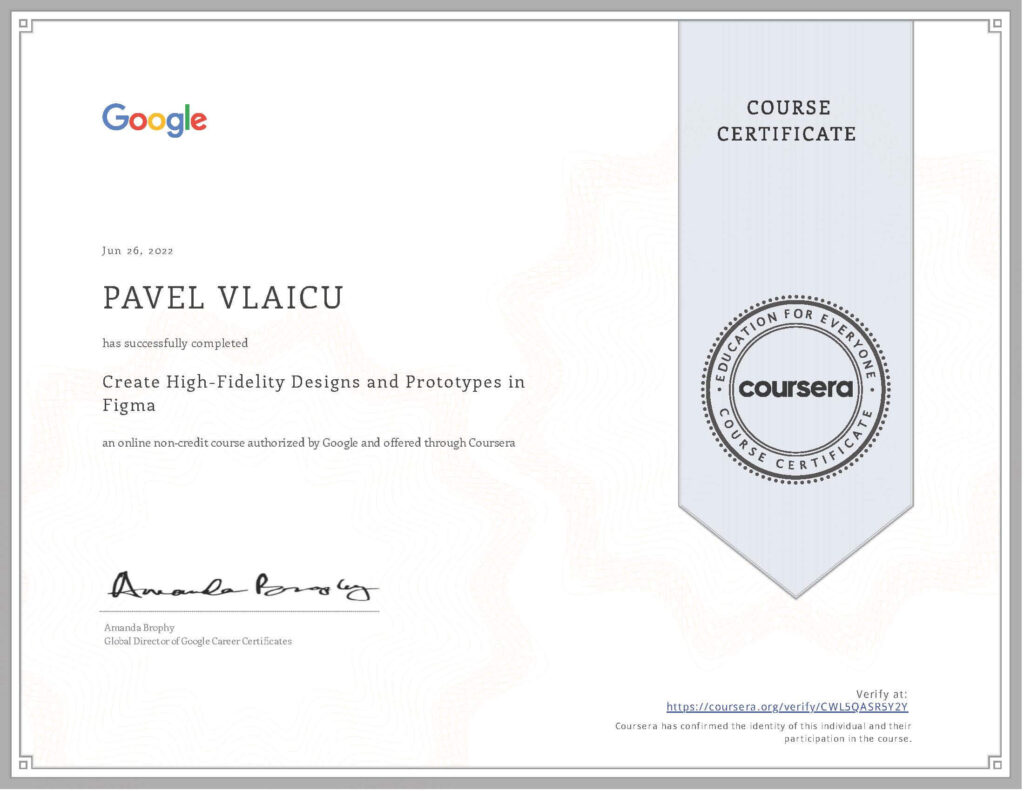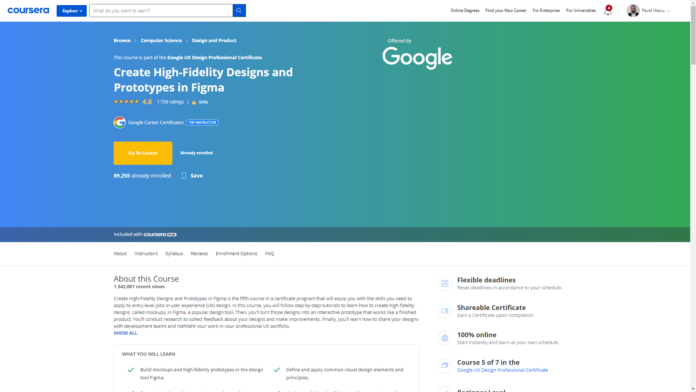About this Course
Create High-Fidelity Designs and Prototypes in Figma is the fifth course in a certificate program that will equip you with the skills you need to apply to entry-level jobs in user experience (UX) design. In this course, you will follow step-by-step tutorials to learn how to create high-fidelity designs, called mockups, in Figma, a popular design tool. Then, you’ll turn those designs into an interactive prototype that works like a finished product. You’ll conduct research to collect feedback about your designs and make improvements. Finally, you’ll learn how to share your designs with development teams and highlight your work in your professional UX portfolio.
Current UX designers and researchers at Google will serve as your instructors, and you will complete hands-on activities that simulate real-world UX design scenarios. Learners who complete the seven courses in this certificate program should be equipped to apply for entry-level jobs as UX designers.
By the end of this course, you will be able to:
– Build mockups and high-fidelity prototypes in Figma.
– Define and apply common visual design elements and principles.
– Demonstrate how design systems can be used to organize, standardize, and enhance designs.
– Understand the role of design critique sessions and feedback while iterating on designs.
– Learn how to hand off finished design projects to engineering teams.
– Complete mobile app designs to include in a professional UX portfolio.
This course is suitable for beginner-level UX designers who have completed the previous four courses of the Google UX Design Certificate. Alternatively, learners who have not completed the previous courses should have a strong understanding of the design process, how to create low-fidelity designs on paper and in Figma, and how to conduct usability studies.
What you will learn
Build mockups and high-fidelity prototypes in the design tool Figma.
Define and apply common visual design elements and principles.
Demonstrate how design systems can be used to organize, standardize, and enhance designs.
Understand the role of design critique sessions and feedback while iterating on designs.
Skills you will gain
User Experience (UX)
mockup
Figma
Prototype
User Experience Design (UXD)
Instructor
Google Career Certificates
Offered by
Google Career Certificates are part of Grow with Google, an initiative that draws on Google’s 20-year history of building products, platforms, and services that help people and businesses grow. Through programs like these, we aim to help everyone– those who make up the workforce of today and the students who will drive the workforce of tomorrow – access the best of Google’s training and tools to grow their skills, careers, and businesses.
Syllabus – What you will learn from this course
Week 1
Starting to create mockups
Turn your focus to visual design, which is how a product or technology appears to users. In this part of the course, you’ll start to create mockups, which are high-fidelity designs that represent a final product. To create mockups, you’ll use visual design elements, like typography, color, and iconography. Elements are often arranged into layouts using methods like grids, containment, and negative space. You’ll apply all of these visual design learnings to build on the mobile app designs you’ve been working on throughout the certificate program.
Week 2
Applying visual design principles to mockups
In this part of the course, you’ll use visual design principles to refine mockups. First, you’ll use emphasis to guide users to the most important parts of a page. Next, you’ll apply hierarchy, scale, and proportion to organize the elements on each page of your app. Then, you’ll consider unity and variety to help elements of your app function together or stand out. Finally, you’ll revisit Gestalt Principles, like similarity, proximity, and common region, to help users interpret your designs easily.
Week 3
Exploring design systems
Come explore the world of design systems! In this part of the course, you’ll be introduced to the parts of a design system, as well as the benefits of using a design system. You’ll examine various companies’ design systems, and you’ll have an opportunity to use them in your own mockups. You’ll also learn how to use and create sticker sheets in Figma.
Week 4
Participating in design critique sessions
Giving, receiving, and implementing feedback is a necessary part of the UX design process. In this part of the course, you’ll explore effective methods for giving and receiving feedback. You’ll also learn about design critique sessions, which will be an important part of your first job as a UX designer. Finally, you’ll learn how to turn feedback into actionable steps that you can take to revise designs.
Week 5
Creating high-fidelity prototypes
You’re ready to build high-fidelity prototypes in Figma! Following six steps, you’ll turn your mockups into a prototype that’s ready for testing. In addition, you’ll explore two new concepts, gestures and motion, which can help enrich the user experience and increase the usability of prototypes.
Week 6
Testing and iterating on designs
Now that you have a high-fidelity prototype, it’s time to test your designs. To get started, you’ll conduct a usability study to test your high-fidelity prototype of a mobile app. You’ll analyze the feedback you receive to come up with actionable insights and iterate on your designs. Then, you’ll learn how to hand off designs to engineers for production. Finally, you’ll turn everything you’ve learned about user research, ideation, wireframes, designs, and prototypes into a case study for your professional UX portfolio.

